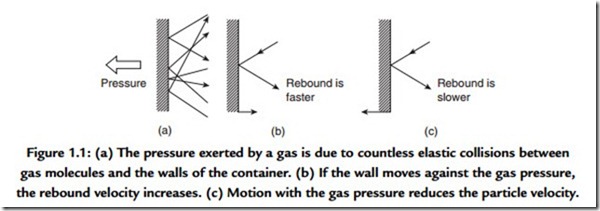The Physics of Sound
Sound is simply an airborne version of vibration. The air which carries sound is a mixture of gases. In gases, the molecules contain so much energy that they break free from their neighbors and rush around at high speed. As Figure 1.1(a) shows, the innumerable elastic collisions of these high-speed molecules produce pressure on the walls of any gas container. If left undisturbed in a container at a constant temperature, eventually the pressure throughout would be constant and uniform.
Sound disturbs this simple picture. Figure 1.1(b) shows that a solid object which moves against gas pressure increases the velocity of the rebounding molecules, whereas in Figure 1.1(c) one moving with gas pressure reduces that velocity. The average velocity and the displacement of all the molecules in a layer of air near a moving body is the same as the velocity and displacement of the body. Movement of the body results in a local increase or decrease in pressure of some kind. Thus sound is both a pressure and a velocity disturbance.
Despite the fact that a gas contains endlessly colliding molecules, a small mass or particle of gas can have stable characteristics because the molecules leaving are replaced by new ones with identical statistics. As a result, acoustics seldom need to consider the molecular structure of air and the constant motion can be neglected. Thus when particle velocity
and displacement are considered, this refers to the average values of a large number of molecules. In an undisturbed container of gas, the particle velocity and displacement will both be zero everywhere.
When the volume of a fixed mass of gas is reduced, the pressure rises. The gas acts like a spring; it is compliant. However, a gas also has mass. Sound travels through air by an
interaction between the mass and the compliance. Imagine pushing a mass via a spring. It would not move immediately because the spring would have to be compressed in order to transmit a force. If a second mass is connected to the first by another spring, it would start to move even later. Thus the speed of a disturbance in a mass/spring system depends on the mass and the stiffness. Sound travels through air without a net movement of the air.
The speed of sound is proportional to the square root of the absolute temperature. On earth, temperature changes with respect to absolute zero (-273°C) also amount to around 1% except in extremely inhospitable places. The speed of sound experienced by most of us is about 1000 ft per second or 344 m per second.
